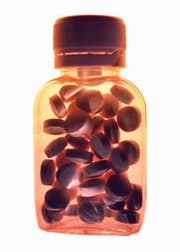UPDATE: September 2024: There are now a couple of smart-phone apps that are MUCH easier to use than the cool but somewhat clumsy calculator described in my original post!!
DMinder (iOS/Android)
Vitamin D and UV Tracker (Android)
SunDay Vitamin D and UV Tracker (iOS)
There’s been a lot of hand-wringing lately about people not getting enough vitamin D. Deficiency is quite common–especially among kids, the elderly, and those with dark skin. And a growing list of diseases and conditions are being linked with vitamin D deficiency. (See also Your Brain on Vitamin D)
Exposure to the sun, without sunscreen, causes your skin to produce vitamin D naturally.
How much sun does it take to satisfy your vitamin D requirements?
If you’ve read anything about this, you’ve probably seen some vague guidelines, recommending “a few minutes every day.” But these recommendations are far too general to be useful. The amount of sun you need to meet your vitamin D requirements varies hugely depending on your location, your skin type, the time of year, the time of day, and even the atmospheric conditions.
A Cool Tool: The vitamin D/UV calculator
Scientists at the Norwegian Institute for Air Research have devised a calculator that will take all those factors into consideration and estimate how many minutes of exposure you need for your skin to produce 25 mcg (the equivalent of 1,000 International Units) of vitamin D.
It’s a very cool tool and the best I’ve seen so far. Be forewarned: It’s not the most user-friendly interface and its very easy to enter the wrong information, which makes your results misleading. But once you get past the technicalities, it’s very interesting to see how much the answers change when you vary the input.
Here are some tips to help you get good results
1. Unless you live in one of a few European or African cities listed as options, you’ll need to determine your latitude and longitude. A GPS device will tell you your lat/long. You can also find this information here. VERY IMPORTANT: The program reads all latitudes as N and all longitudes as E. If your latitude is 39 S, enter -39. If your longitude is 76 W, enter -76. (It took me forever to figure out this quirk!) Also, be sure to click the radio button next to your latitude and longitude entries. It is not automatically selected when you fill in these values.
2. You also need to estimate your complexion, and the options include both “blond” and “pale,” which is a little confusing. (Maybe it makes more sense to Norwegians.) Basically, the six categories are arranged from lightest (pale) to darkest (black). Make your best guess based on that. I have dark eyes and hair so I chose “darker caucasian.”
3. Enter the time of day you are going out in the sun, expressed as UTC (aka Greenwich Mean Time). Here is a converter that will convert local time into UTC. The calculator uses a 24 hour clock, so hours from 1pm to midnight are expressed as 13 to 24. There is also an option that lets you choose “about midday.” If you enter an actual time, be sure to click the radio button next to your start time. It doesn’t move automatically when you fill in these values.
4. Next, enter how much cloud cover there is. If you choose “overcast,” you can also enter in the UV Index from your local newspaper’s weather page and the program will estimate the thickness of the cloud deck. Again, be sure to click the radio button if you choose this option. (Disclaimer: I played around with this and couldn’t see that changing the UV index had any effect…)
5. You’re almost done! Next, the calculator wants to know the thickness of the ozone layer. I have to admit, I was unable to find a simple resource to help with this one. Unless you live under the ozone hole or have some other way of knowing that the ozone is particularly thick or thin where you are, I suggest just setting this one to medium.
6. Find your altitude. Some GPS devices can tell you your altitude, as can Google Earth or topographical maps. But the easiest way may be to simply google “altitude of [your town]”. Remember to convert it to kilometers. One kilometer = about 3300 feet.
7. Choose your surface.
Here’s what my form looks like all filled in:

When I submit it for calculation, I learn that here in Baltimore, on a cloudless July day at noon, I need to spend just 5 minutes with my face, hands, and arms exposed to produce 25 mcg (1,000 IU) of vitamin D. If it were November, I’d need to stay out about half an hour. If it were November, and I were black, it would take an hour and a half. You get the idea. For most of the year, “a few minutes” of sun would not be enough for me to make enough vitamin D.
Keep in mind that these exposure times are considered enough to maintain healthy vitamin D status. if you are starting out with a vitamin D deficiency, you might need more.
One last thought: Unprotected sun exposure also increases the risk of skin cancer and premature aging of the skin. After you’ve gotten your daily “dose,” I recommend applying a good sunscreen!
 I was just reading a very interesting article on the safety of imported foods. Unfortunately, the publication (ADA Times) is for members of the American Dietetic Association so I can’t post a link for you. But here are a few nuggets you might like to know (with thanks to managing editor Liz Spittler, who researched and wrote the article).
I was just reading a very interesting article on the safety of imported foods. Unfortunately, the publication (ADA Times) is for members of the American Dietetic Association so I can’t post a link for you. But here are a few nuggets you might like to know (with thanks to managing editor Liz Spittler, who researched and wrote the article).
 Q. I’ve read a lot about the health benefits of Vitamin D. But isn’t there also a limit of how much Vitamin D I should supplement? Is there a danger or limit that avoids a possible toxic amount?
Q. I’ve read a lot about the health benefits of Vitamin D. But isn’t there also a limit of how much Vitamin D I should supplement? Is there a danger or limit that avoids a possible toxic amount?